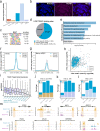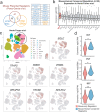A genome-wide CRISPR-Cas9 knockout screen identifies essential and growth-restricting genes in human trophoblast stem cells
- PMID: 35538076
- PMCID: PMC9090837
- DOI: 10.1038/s41467-022-30207-9
A genome-wide CRISPR-Cas9 knockout screen identifies essential and growth-restricting genes in human trophoblast stem cells
Abstract
The recent derivation of human trophoblast stem cells (hTSCs) provides a scalable in vitro model system of human placental development, but the molecular regulators of hTSC identity have not been systematically explored thus far. Here, we utilize a genome-wide CRISPR-Cas9 knockout screen to comprehensively identify essential and growth-restricting genes in hTSCs. By cross-referencing our data to those from similar genetic screens performed in other cell types, as well as gene expression data from early human embryos, we define hTSC-specific and -enriched regulators. These include both well-established and previously uncharacterized trophoblast regulators, such as ARID3A, GATA2, and TEAD1 (essential), and GCM1, PTPN14, and TET2 (growth-restricting). Integrated analysis of chromatin accessibility, gene expression, and genome-wide location data reveals that the transcription factor TEAD1 regulates the expression of many trophoblast regulators in hTSCs. In the absence of TEAD1, hTSCs fail to complete faithful differentiation into extravillous trophoblast (EVT) cells and instead show a bias towards syncytiotrophoblast (STB) differentiation, thus indicating that this transcription factor safeguards the bipotent lineage potential of hTSCs. Overall, our study provides a valuable resource for dissecting the molecular regulation of human placental development and diseases.
© 2022. The Author(s).
Conflict of interest statement
The authors declare no competing interests.
Figures






Similar articles
-
Hypoxia and loss of GCM1 expression prevent differentiation and contact inhibition in human trophoblast stem cells.Stem Cell Reports. 2025 May 13;20(5):102481. doi: 10.1016/j.stemcr.2025.102481. Epub 2025 Apr 24. Stem Cell Reports. 2025. PMID: 40280139 Free PMC article.
-
Generation of Human Trophoblast Stem Cell-Dependent Placental In Vitro Models.Methods Mol Biol. 2024;2767:43-52. doi: 10.1007/7651_2022_463. Methods Mol Biol. 2024. PMID: 36515896
-
Laminin switches terminal differentiation fate of human trophoblast stem cells under chemically defined culture conditions.J Biol Chem. 2023 May;299(5):104650. doi: 10.1016/j.jbc.2023.104650. Epub 2023 Mar 25. J Biol Chem. 2023. PMID: 36972789 Free PMC article.
-
Accessing the human trophoblast stem cell state from pluripotent and somatic cells.Cell Mol Life Sci. 2022 Nov 25;79(12):604. doi: 10.1007/s00018-022-04549-y. Cell Mol Life Sci. 2022. PMID: 36434136 Free PMC article. Review.
-
Here and there a trophoblast, a transcriptional evaluation of trophoblast cell models.Cell Mol Life Sci. 2022 Nov 8;79(12):584. doi: 10.1007/s00018-022-04589-4. Cell Mol Life Sci. 2022. PMID: 36346530 Free PMC article. Review.
Cited by
-
The multifaceted role of GCM1 during trophoblast differentiation in the human placenta.Proc Natl Acad Sci U S A. 2022 Dec 6;119(49):e2203071119. doi: 10.1073/pnas.2203071119. Epub 2022 Nov 28. Proc Natl Acad Sci U S A. 2022. PMID: 36442132 Free PMC article.
-
Arrayed CRISPR/Cas9 Screening for the Functional Validation of Cancer Genetic Dependencies.Bio Protoc. 2022 Dec 20;12(24):e4577. doi: 10.21769/BioProtoc.4577. eCollection 2022 Dec 20. Bio Protoc. 2022. PMID: 36618092 Free PMC article.
-
Modeling human extraembryonic mesoderm cells using naive pluripotent stem cells.Cell Stem Cell. 2022 Sep 1;29(9):1346-1365.e10. doi: 10.1016/j.stem.2022.08.001. Cell Stem Cell. 2022. PMID: 36055191 Free PMC article.
-
Chemical conversion of human conventional PSCs to TSCs following transient naive gene activation.EMBO Rep. 2023 Apr 5;24(4):e55235. doi: 10.15252/embr.202255235. Epub 2023 Feb 27. EMBO Rep. 2023. PMID: 36847616 Free PMC article.
-
The multifaceted roles of the transcriptional coactivator TAZ in extravillous trophoblast development of the human placenta.Proc Natl Acad Sci U S A. 2025 Apr 22;122(16):e2426385122. doi: 10.1073/pnas.2426385122. Epub 2025 Apr 14. Proc Natl Acad Sci U S A. 2025. PMID: 40228123 Free PMC article.
References
Publication types
MeSH terms
Substances
Grants and funding
LinkOut - more resources
Full Text Sources
Molecular Biology Databases
Research Materials

